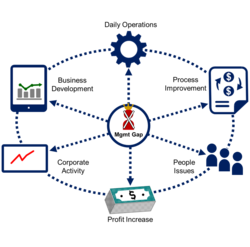Advisory Board & Interim Management

You constantly benchmark your portfolio against functionality, user experience and future demand.
The composition of your company's advisory board plays an important role for potential growth and strategy.
⇒ APILANi is your #1 Enterprise Alliance Partner to shape your company's future with …
Advisory Board

As technology experts and opinion leaders, we also work together with Technology companies by taking on advisory board mandates. The composition of your company advisory board plays an important role in the assessment of potential and the associated company strategy for your product or your product line.
APILANi helps you to fill your company advisory board correctly by taking on the mandate ourselves or by recommending a suitable person or group of persons. In our opinion, the open exchange of ideas and assessments works best in a manageable group of four to eight experts.
The advantages and disadvantages of your product strategy can be weighed up in a trusting atmosphere if the experts can openly express concerns, critical opinions or objections instead of just agreeing with your own suggestions.
Overview: Functions of an Advisory Board
| Function Area | Main Roles & Contributions | Exemplary Effects |
|---|---|---|
| 1. Strategic Guidance | ➡️ supports management in defining and executing strategy ➡️ evaluates growth opportunities, markets and investments ➡️ acts as a sparring partner for long-term decisions | ✅ clear strategic direction ✅ improved decision quality ✅ better market positioning |
| 2. Professional Expertise | ➡️ provides deep industry and technical knowledge ➡️ identifies trends, opportunities and risks ➡️ brings access to specialized know-how | ✅ faster innovation cycles ✅ reduced risk exposure ✅ access to best practices |
| 3. Mentoring & Sparring | ➡️ offers coaching and constructive feedback to leaders ➡️ challenges assumptions and strategic choices ➡️ encourages leadership and personal growth | ✅ stronger leadership culture ✅ higher management performance ✅ increased strategic confidence |
| 4. Networking & Reputation | ➡️ connects the company with investors, partners and key stakeholders ➡️ enhances credibility and external reputation ➡️ supports business development and partnerships | ✅ new partnerships and clients ✅ improved investor relations ✅ enhanced brand trust |
| 5. Governance & Oversight (informal) | ➡️ reviews strategic alignment and sustainability ➡️ promotes transparent corporate governance ➡️ as an early warning system for risks | ✅ better governance structure ✅ early risk detection ✅ increased stakeholder confidence |
| 6. Innovation & Future Orientation | ➡️ drives innovation, digital transformation and modernization ➡️ supports the creation of new business models ➡️ provides direction for sustainable long-term growth | ✅ competitive advantage ✅ future-ready organization ✅ sustainable growth initiatives |
⇒ With APILANi you have a competent advisor as ‘sparring partner’ with whom you can shape the future of your company successfully. 👉📧
Interim Management

In the event of a management gap in your company, you have the opportunity to relieve the management and executives of urgent projects by using an interim manager and thus close the gap immediately.
Through the need-based selection of the required technical expertise and the time limit of the interim management, you get a far better cost-benefit ratio than by not filling the management gap.
In addition, the external interim manager brings new knowledge and methods from previous reference projects and an unbiased perspective when assessing difficult situations within your company.
Overview: Areas of responsibility of an Interim Manager
| Function Area | Key Tasks / Activities | Objectives / Benefits |
|---|---|---|
| 1. Strategic Leadership | ➡️ analyze the company’s current situation ➡️ develop short- and long-term strategies ➡️ lead business transformation initiatives | ✅ define clear direction ✅ ensure long-term competitiveness |
| 2. Operational Management | ➡️ temporarily take over leadership roles ➡️ optimize and streamline business processes ➡️ implement new IT or management systems | ✅ stabilize daily operations ✅ improve efficiency and performance |
| 3. Change Management & Communication | ➡️ lead organizational change initiatives ➡️ communicate with employees and stakeholders ➡️ coach and mentor internal leaders | ✅ increase acceptance and motivation ✅ secure sustainable transformation |
| 4. Financial & Economic Control | ➡️ manage liquidity and costs ➡️ develop and execute restructuring plans ➡️ establish controlling and reporting systems | ✅ restore financial stability ✅ increase transparency and accountability |
| 5. Project & Transition Management | ➡️ manage critical projects on a temporary basis ➡️ bridge leadership gaps ➡️ stabilize operations during transitions | ✅ ensure business continuity ✅ successfully deliver key projects |
| 6. Knowledge Transfer & Successor Development | ➡️ transfer know-how to internal teams ➡️ train and onboard successors ➡️ build internal competencies | ✅ enable smooth handover ✅ strengthen long-term capabilities |